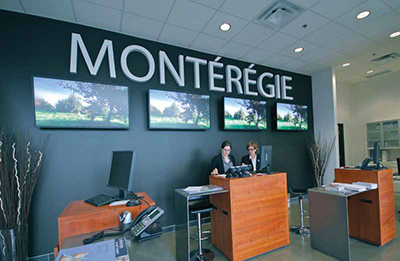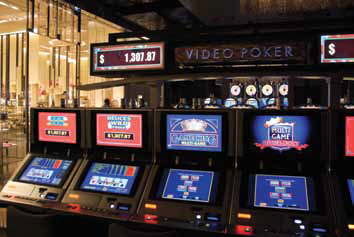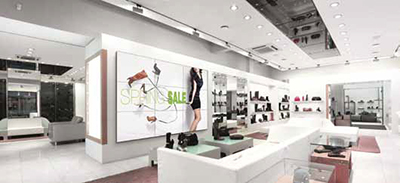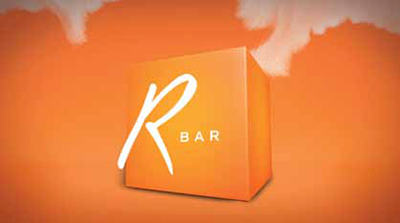How Digital Signage Can Build Your Brand

When Courtyard by Marriott embarked on a redesign of its lobbies, it wasn’t for the sake of redecorating—it was to boost its bottom line. For the hotel chain, this meant improving the guest experience, rendering visitors more loyal and committed to its brand.
Thus began a partnership between the Denver, Colorado-based digital signage solutions developer Four Winds Interactive LLC (FWi) and USAToday. The result: the Marriott Courtyard GoBoard, an interactive digital signage system that serves as a “technological centerpiece” in hundreds of hotel lobbies. Running off of FWi’s software platform, the 55- to 57-inch displays offer guests the ability to control the output of the screen, giving them access to live news from USA Today, weather forecasts, stock market quotes, information on airport delays, as well as listings for local events and restaurants.
According to FWi, Courtyard by Marriot has reported that guests and hotel staff interact more easily since the rollout, with a 10 percent increase in guest satisfaction and a 27 percent rise in intent-to-return scores.
David Levin, president, FWi, noted that the Marriott Courtyard GoBoard is just one example of how companies are using digital signage technology to encourage customers to interact with their brands. He explained that in many cases, brands see the potential return on investment before he has to point it out. “Some of the arguments for ROI that we hear from customers are around customer satisfaction, guest satisfaction, and overall visitor experience,” he said. If you satisfy those things, or improve the overall experience, customers will naturally be more loyal, he said.
MESSAGING AT THE POINT OF PURCHASE
In the retail environment, digital signage enables companies to transmit branding messages right at the point of purchase—a far more powerful way to influence consumers’ purchasing decisions than traditional marketing methods, argued Karl Demanss, Panasonic’s group manager of professional displays and digital signage. “Right there at the point of purchase, if you capture them, they have the money in their pocket and they are going to spend it,” he said. “Now they are going to spend it on your product because they saw your branded message over everything else.”
With the technology in place, the content needs to be equally compelling. You can’t offer subpar content at the point of purchase, Demanss advised.
A daily selection of features, industry news, and analysis for tech managers. Sign up below.
DIGITAL SIGNAGE GIVES AD AGENCY A NEW EDGE
If there is one name synonymous with advertising, it is Leo Burnett. Since its founding in 1935, the agency has created many iconic characters and campaigns that have become part of the fabric of American (and global) culture. From the household names Burnett has helped Procter & Gamble build for its brands, to commercials featuring the Kellogg’s Tony the Tiger, the lonely Maytag Repairman, or the Allstate “Mayhem” man, the agency’s work has touched the awareness of millions of people. Even people who know nothing about the advertising or marketing business recognize the name Leo Burnett.

From interactive wayfinding to casino end caps, MGM’s in-house technology team says that their brand is significantly stronger due to digital signage.But despite the ubiquity of its ad and commercial campaigns, Burnett, like many large organizations, found that keeping employees up-to-date on happenings around the agency—the latest work with commercials, the many events, client wins, and other good news and opportunities—was challenging, even within the company’s Chicago headquarters.
“Aside from e-mail there was no real centralized way to get the information out there,” said Jenny Hackett, associate director of internal communications for Leo Burnett. The sheer size of the headquarters office, which occupies 16 floors in the Leo Burnett Building in Chicago, also complicated corporate communications. Since everyone on a given client team works on the same floor, employees have little reason to visit other floors, which means they tended to see only work produced on that floor.
These issues were also on the mind of Tyler Anastasia, vice president of internal communications at Burnett, after he viewed dynamic video displays at several hotels and resorts. The screens he saw not only displayed basic textual information about events happening in the building, but still photos, video, wayfinding information, special offers, and more. The experience struck a creative nerve for Anastasia: “The days of the old text ‘reader’ boards in hotel lobbies were over. Video, graphics, and sound were informing and engaging visitors.”
“We are a creative agency, and things need to look a certain way for our people to engage with them,” said Hackett. She said that without a full-time manager of a new system, the technology had to be very easy to use and self-sustaining. Most of all, the digital content management system had to make everything look like it was from Burnett, with the branding and colors that are part of their “Humankind initiative.”
After reviewing several options, the Burnett team engaged with Four Winds Interactive to help them create and implement the new digital signage strategy.
“FWi was involved in the technical aspects very early in the development process,” said Carol Beilfuss, project manager at Burnett. “They listened to what we wanted to do and made suggestions on how we could best accomplish our goals. They also showed us how we could schedule new information and video clips so they come up at the right time—such as a welcome screen or the client’s latest commercial when they come for a visit. We can group the work when we have time and then set it to appear whenever we want, which is huge for us.”
Burnett’s Creative Services department also was brought into the project early to help develop the look, feel, and atmosphere around it. One of their first moves was to christen it the “Burnettwork,” which gave the system an identity beyond just an installation of display screens.
“We did a survey not too long ago to gauge reactions and acceptance of the Burnettwork,” said Hackett. “Everyone had great things to say about it. Many told us they’re now more aware of what’s happening within the company and outside their client teams.”
SIGNAGE THAT TELLS A STORY
Another way that organizations are using digital signage to build their brands is through storytelling. Demanss uses his own company as an example: “When you walk into our new facility in Newark, you will be greeted with the history of Panasonic. Why Panasonic? What current initiatives we are involved in. Why we are a green company. We are not selling a product—we’re telling you about who we are and why you want to do business with us.” After the story is told, then customers can begin to discover the company’s individual products.

Kroger aligns its brand with health and wellness.But like most technological deployments, a digital signage rollout requires thoughtful planning— especially in the area of content management, noted John Sheehan, director of integrated media at NEC Display Solutions in Irving, Texas. “Ongoing resources are needed, and there’s a learning curve as they adapt to the new ways of bringing the message out,” he said, adding that organizations run into trouble when they approach digital signage on a piecemeal basis. “When you design a system, every consideration must be taken into account. Every component, every part of your company, every piece of the solution needs to be thought out and brought in early to address the situations well before the installation phase.” Everyone that will “touch” the digital signage system—be it IT or marketing—should be involved in the design phase.
“If you look at a typical implementation, there are a lot of different pieces of content that are presented on that screen, and a lot of the content comes from different areas of an organization,” Levin conceded. And the content may arrive via an interface to another system, or it may be entered by an individual. “There are a lot of people that can affect the information that is up there on the screen.”
While this is an operational challenge, it can, in part, be handled technologically. “I think how we solve the technological challenge is to automate the information that goes to the screens by connecting it to third-party systems, or the data source,” Levin said. “That means that an individual doesn’t have to update it; the information just flows automatically from the source.”
Having information flow over the network is another issue that organizations face, Demanss pointed out. “You need to create a communications infrastructure where you can put this highquality content out over a network, but a lot of times it’s going to go over the same network as all of the standard informational traffic for communications within the facility—e-mails, Internet, and so on,” he said. This is further complicated in a retail environment, where streaming video over the same network that is handling point-of-sale transactions is largely frowned upon.

Flat-panel solutions from Samsung help energize the decor, communicate with customers, and customize this retail
environment. To overcome this, Demanss suggests the “store and forward” method, where content is pushed out to a local media player or a local server a low traffic times—very often the earliest hours of the morning. “You can push all of the content that you want out there, and then in the morning you fire it up and your branding message is there for the day. It involves a little bit of pre-planning for your marketing department, but you can get the message out.”
As brands continue to roll out larger displays, Levin noted that the next step is taking this branding experience to the smaller screen. “Everybody carries what we used to think of as a digital sign in their hand,” he said. These days, consumers are demanding that information flow from public displays to their personal smartphones. “A customer needs to be able to walk up to a screen, get that information and if they want to take it with them, transfer it down to their mobile device.”
Compelling graphics reinforce the R Bar’s sophisticated brand identity at Maryland Live! Casino.Carolyn Heinze is a freelance writer/editor. Tech Image contributed content on Leo Burnett’s system.

info
Four Winds Interactive (FWi)
fourwindsinteractive.com
NEC Display Solutions
necdisplay.com
Panasonic
panasonic.com
Samsung
samsung.com
MGM Resorts International Makes Each Visitor a VIP
/ / / / / / By Randy Dearborn
A key element to creating a successful hotel guest experience revolves around communicating the right information to guests at their convenience. While MGM Resorts International operates some of the most prominent resorts in Las Vegas, we had relied on costly, cluttered static signage to promote our broad range of activities and restaurants.
Beginning in 2006, I sought to learn more about our guests’ patterns and conducted pilot tests of new communications concepts. I noticed the strong need to better promote in-house clubs, restaurants, bars and shows in order to set us apart from our competitors. Static posters lacked the media-rich environment that digital signage brings to the forefront, and we wanted to use interactive content to promote each venue’s appeal according to guests’ individual desires—from availability of dinner reservations to suggested entertainment.
We found a strong need for wayfinding, as many guests can become overwhelmed with the vast options accessible to them. To combat this challenge, as well as resolving the need to better promote ourselves, we installed roughly 700 NEC displays for digital signage across our properties. From interactive wayfinding and casino end caps to touchscreen menu boards and lobby video walls, MGM’s brand is significantly more evident and easier to digest for newcomers.
Our Multimedia Team had familiarity with a variety of display manufacturers, but we chose NEC Display Solutions based on years of positive experience with its impeccable reliability and industrial-strength design, which is ideal for the non-stop Las Vegas environment. The displays range in size from 32- to 82-inch and include three video walls using 16 displays each for a total of 48 NEC displays that work together to advertise upcoming events and connect with guests using social media. The content is managed remotely by an internal team, which controls hardware, software and scheduling on a 24/7 basis. We rely on Apple’s Mac Mini for players connected to the displays and a special Mac version of Four Winds Interactive software for scheduling content.
We now have digital menu boards at more than 50 restaurants, which utilize NEC’s 32-inch and 40-inch LCD displays and Richardson Electronics’ touch overlays to allow guests to make dining reservations, review menus and view entrée photos. Each restaurant’s staff is able to change menu specials and line items in real time through an internal web portal, which then automatically updates the signs without needing to engage the content management team.
MGM prefers NEC products because we never have to worry about burn-in issues, scalability or screen failure. They’re reliable and have great image quality. We continue to plan additional implementations of NEC digital signage and test new uses and applications, including a larger focus on the integration of social media and multi-touch video walls.
Randy Dearborn is vice president of multimedia & guest technology at MGM Resorts International. He can be reached at dearborn@mgmresorts.com.
A SPACE ODYSSEY
Take Your Digital Signage Network Into a New Domain
/ / / / / / / By Peter T. Vrettas
When you walk through your facility, is your digital signage network just showing news feeds? Lost in Space reruns? Nothing at all? If so, your network needs to go where it has never gone before, with messaging that tells the story of your brand and expands its relevance to your customers.
We’re not talking science fiction. Well, perhaps we are. Like Klaatu in The Day the Earth Stood Still, you have the technological power to inform, enlighten, and change behavior. Here are some reflections on digital signage and brand extension, inspired by some great sci-fi movies. Can you identify them?
“I’ve watched C-beams glitter in the dark near the Tannhauser Gate...” Memorable images and sounds are so powerful, even a replicant can’t forget them (let alone a human). Today’s marketers know how to create a unique brand that has an indelible impact on consumers’ minds and hearts. Your signage network gives you the opportunity to define, harness, and grow the power of your brand. That will take vision, leadership, and long-term commitment. Are you ready?
“Do-Doo-DOO-Do-DUMM.” Like the alien ship at Devil’s Tower, begin by opening a harmonious line of communication with your marketing colleagues. They can help you depict your brand image correctly. If they haven’t already, sooner or later they’ll probably express an interest in your network, so it’s better to sign an intergalactic treaty now than to come into conflict later.
“Do…or do not. There is no try.” Don’t just trust the Force. Execute a plan. Begin by incorporating your logo and color palette on-screen. Promote your most compelling products and services. Then take communications up a notch by identifying other messaging categories that enhance your brand story and can be easily updated month after month. Consider operating philosophy and principles; relevant “fun facts” and trivia; organizational heroes; industry firsts; awards; special events; and sponsorships. Let your brand be your guide.
“Are you telling me you built a time machine...out of a DeLorean?” When it comes to creating messaging, do it in style. Set your DIY tendencies aside and find a graphics designer. That person can bring a creative sensibility to your content that you might not have the time, inclination, or ability to achieve yourself.
“I’m sorry, Dave, I’m afraid I can’t do that.” Sometimes the needs of the many seem to overwhelm the needs of the few, but one person always has to have the final say. Identify the “HAL” on your team—working with a content management firm, if necessary—who will review, approve, coordinate, and schedule all content on your software of choice. Your network will establish a consistent track record of quality, reliability, and relevance—and that in itself will also enhance the power of your brand.
“To infinity and beyond!” Ready for more? Build brand buzz and jump a light year ahead of the competition with mobile and interactive tactics. Digital Signage Expo 2013 is a great place to explore all the possibilities.
The answer key: 1. Blade Runner (1982) 2. Close Encounters of the Third Kind (1977) 3. The Empire Strikes Back (1980) 4. Back to the Future (1985) 5. 2001: A Space Odyssey (1968) 6. Okay, I cheated a little. It’s Toy Story (1995)
Peter T. Vrettas is the CEO of EDR Media, a media development company that produces consumer-focused media for television networks, retail stores, sports venues, and resort/casino digital signage networks. Vrettas is a DSE 2013 Advisory Board member of the Content Council. Visit digitalsignageexpo.net to learn more.
Carolyn Heinze has covered everything from AV/IT and business to cowboys and cowgirls ... and the horses they love. She was the Paris contributing editor for the pan-European site Running in Heels, providing news and views on fashion, culture, and the arts for her column, “France in Your Pants.” She has also contributed critiques of foreign cinema and French politics for the politico-literary site, The New Vulgate.
